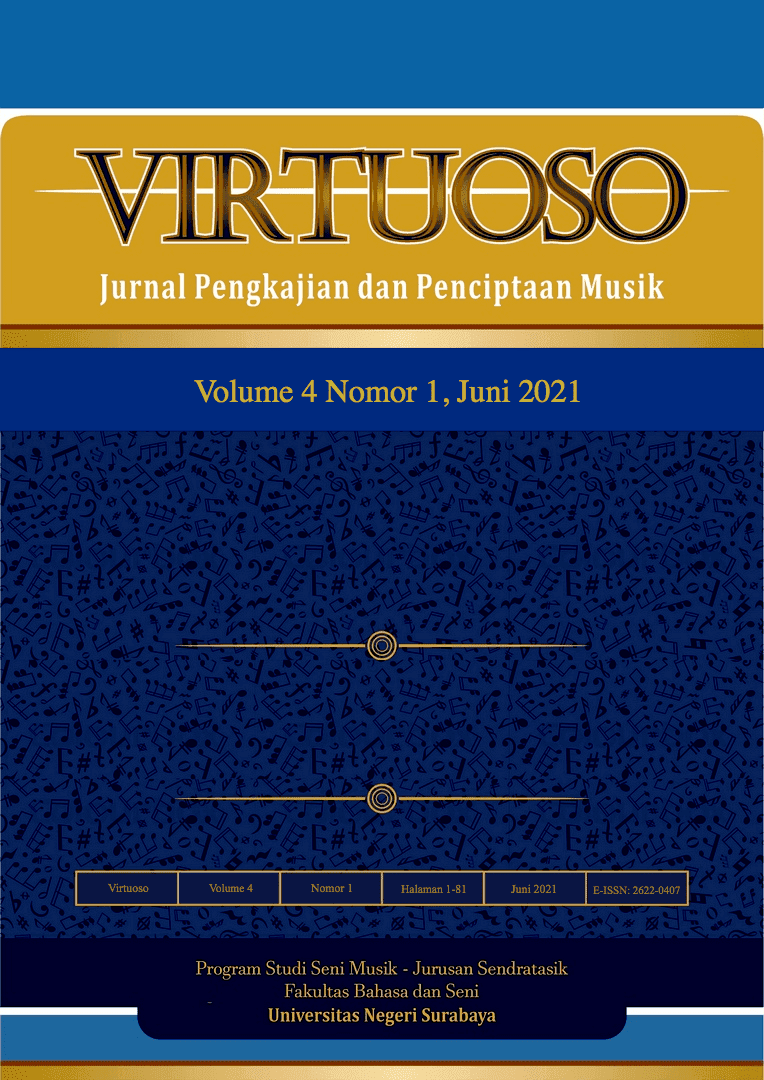Species Counterpoint: Pendekatan Dalam Pembelajaran Kontrapung
Main Article Content
Abstract
As a part of music theory, Counterpoint dealing with a combination of melody in contrary motion. It is focused on combining melody between cantus firmus and counterpoint. In learning counterpoint, there are two approaches which usually used, free Counterpoint and strict counterpoint (it is well known as species counterpoint). The free counterpoint method allows writing counterpoint melody without paying attention to Counterpoint rules. While in strict counterpoint does not give freedom to write counterpoint melody, hence in must follow Counterpoint rules. Based on an early observation of this study, it found that the free counterpoint method did not give a strong understanding of basic counterpoint to the students. It is showed that students are confused when they made a Counterpoint melody. They stated that they were confused about how to start the melodies and also how to develop their melody because they dont have a strong basis of counterpoint rules. This research aims to analyze the role of species counterpoint in giving a rudiment to the students. Species counterpoint used here as a pedagogical tool, which makes students learned through several steps called species. This is qualitative research. The data acquired from observation and interviews during learning Counterpoint at Music Education Study Program, Faculty of Performing Arts, Institut Seni Indonesia Yogyakarta. The results showed that species counterpoint builds a strong fundamental theory in writing counterpoint melody. Moreover, it also helps students to increase their skills in writing a counterpoint melody.
Downloads
Article Details

This work is licensed under a Creative Commons Attribution-NonCommercial-ShareAlike 4.0 International License.
The copyright of the received article once accepted for publication shall be assigned to the journal as the publisher of the journal. The intended copyright includes the right to publish the article in various forms (including reprints). The journal maintains the publishing rights to the published articles.
References
Atmadja, B. T. (2009). Pengembangan MetodePembelajaran Mata Kuliah Tari Surakarta Dasar. Resital: Jurnal Seni Pertunjukan (Journal of Performing Arts), 10(2).
Darsono, M. (2000). Belajar dan Pembelajaran. IKIP Semarang Press.
Djamarah, S. B., & Zain, A. (2006). Strategi belajar mengajar. Jakarta: Rineka Cipta, 46.
Huang, C.-Z. A., Cooijmans, T., Roberts, A., Courville, A., & Eck, D. (2019). Counterpoint by convolution. ArXiv Preprint ArXiv:1903.07227.
Indrawan, A. (2015). Adaptasi Konserto pada Ensambel Gitar sebagai Upaya Pengayaan Bahan Ajar Matakuliah Ensambel. Resital: Jurnal Seni Pertunjukan, 16(2).
Jeppesen, K. (2013). Counterpoint: the polyphonic vocal style of the sixteenth century. Courier Corporation.
Laitz, S. G. (2008). The Complete Musician (2nd ed.). New York: Oxford University Press, Inc.
Norden, H. (1969). Fundamental counterpoint. Boston: Crescendo Pub. Co.
Ren, I. Y. (2016). Exploring the rules in species counterpoint. Proceedings of CSMC-16, Https://Csmc2016. Wordpress. Com/Proceedings.
Sugiyono, M. P. K. (2013). Kualitatif, dan Kombinasi (Mixed Methods). Bandung: Alfabeta.
York, F. L. (1907). Counterpoint Simplified: A Text-Book in Simple Strict Counterpoint. Boston: Oliver Ditson Company.

